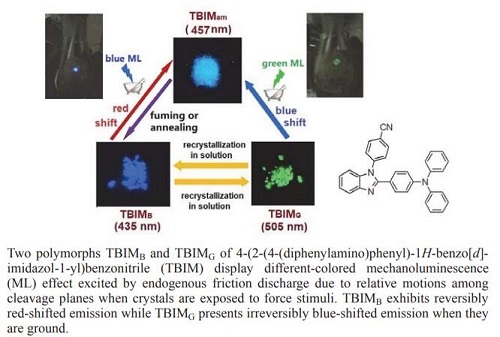摘要/Abstract

通过芳香亲核取代、还原以及DMSO/空气条件下的氧化成环反应合成了(4-二苯氨基苯基)-1H-苯并咪唑基苯腈(TBIM),化合物的溶液经挥发获得两种晶体TBIMB与TBIMG,前者具有深蓝色荧光(435 nm)而后者则具有绿色荧光(505 nm).受力后两者均成为具有青色荧光(457 nm)的无定形粉末,在溶剂熏蒸或热退火条件下前者的荧光可完全恢复,而后者只能转变为前者的荧光.此外,TBIMB与TBIMG晶体受力后可分别发出蓝色(432 nm)和绿色(500 nm)的闪光.两种晶体都属于中心对称空间群且晶体内分子对的净偶极矩几乎为零,压电效应与破碎晶体表面分子对间的放电激发理论并不适用于解释两种晶体的摩擦发光.分子的链状堆积结构使晶体在受力下很容易发生解理并引起解理面之间的相对运动导致内生摩擦放电,从而激发解理面上的分子使之产生荧光辐射,这种机制很有可能是该两种晶体出现摩擦发光活性的主要原因.
关键词: 力致荧光变色, 摩擦发光, 多晶体, 内生摩擦放电, 苯并咪唑
Mechanofluorochromism (MFC) and mechanoluminescence (ML) are two types of significant solid-state optical phenomena which are closely dependent on conformations, packing modes and intermolecular interactions. Herein, through a three-step route involving aromatic nucleophilic substitution, reduction and oxidative cyclization in DMSO under air, a benzo[d]imidazole with triphenylamine and 4-cyanophenyl respectively located at C(2)- and N(1)-position is obtained in good yields. Two polymorphs TBIMB and TBIMG of 4-(2-(4-(diphenylamino)phenyl)-1H-benzo[d]imidazol-1-yl)benzonitrile (TBIM) corespondingly exhibit intense deep-blue (435 nm) and green fluorescence (505 nm). Under force stimuli, both polymorphs turn into amorphous phase with cyan fluorescence (457 nm). By fuming in solvent vapor or annealing treatment, only the ground TBIMB sample can be completely restored into the original crystalline structure, the ground TBIMG sample is just transformed into TBIMBcrystal. It is assumed that the enhanced energy barrier induced by the denser packing in TBIMG crystal makes the conversion from in amorphous phase to crystalline one kinetically infeasible. The crystallography reveals that triphenylamine moiety in TBIMG crystal is less restrained by intermolecular interactions than that in TBIMB crystal, which results in the long-wavelength TICT emission in the former crystal and the short-wavelength LE emission in the latter one. In exposure to force stimuli, TBIMB and TBIMG crystals respectively give out the blue (432 nm) and green (500 nm) flash. It is revealed by crystallography that both polymorphs hold centrosymmetric space groups. DFT calculations based on the molecular couples with strong intermolecular interactions demonstrate that the close-to-zero net dipole moments occurs on these couples. Hence, neither piezoelectric effect nor excitation of molecules on cracked surfaces by discharges between molecular couples should account for the ML behaviors of these two polymorphs. Due to the readily force-induced cleavage of the two crystals by particular chain-shaped packing, the endogenous friction discharge caused by relative movements between cleavage planes would excite molecules on these planes, and this mechanism is assumed to be mainly responsible for the ML activity of the two crystals.
Key words: mechanofluorochromism, mechanoluminescence, polymorphs, endogenous friction discharge, benzimidazole
PDF全文下载地址:
点我下载PDF
